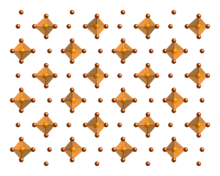
Summary
Phosphorus pentabromide is a reactive, yellow solid of formula PBr5, which has the structure [PBr4]+Br− (tetrabromophosphonium bromide) in the solid state but in the vapor phase is completely dissociated to PBr3 and Br2. Rapid cooling of this phase to 15 K leads to formation of the ionic species phosphorus heptabromide (tetrabromophosphonium tribromide [PBr4]+[Br3]−).[2]

| |

| |
| Names | |
|---|---|
| IUPAC name
Tetrabromophosphanium bromide
| |
| Other names | |
| Identifiers | |
| |
3D model (JSmol)
|
|
| ChemSpider |
|
| ECHA InfoCard | 100.029.260 |
| EC Number |
|
PubChem CID
|
|
| UNII |
|
| UN number | 2691 |
CompTox Dashboard (EPA)
|
|
| |
| |
| Properties | |
| PBr5 | |
| Molar mass | 430.494 g·mol−1 |
| Appearance | Yellow crystalline solid[1] |
| Density | 3.61 g/cm3 |
| Melting point | ca. 100 °C (decomposes) |
| Boiling point | 106 °C (223 °F; 379 K) (decomposes) |
| Reacts with water | |
| Solubility | Decomposes in ethanol Soluble in CCl4 and CS2 |
| Hazards[1] | |
| Occupational safety and health (OHS/OSH): | |
Main hazards
|
Causes severe skin burns and eye damage |
| GHS labelling: | |

| |
| Danger | |
| H314 | |
| P260, P264, P280, P301+P330+P331, P302+P361+P354, P304+P340, P305+P354+P338, P316, P321, P363, P405, P501 | |
| Related compounds | |
Related compounds
|
|
Except where otherwise noted, data are given for materials in their standard state (at 25 °C [77 °F], 100 kPa).
Infobox references
| |
It can be used in organic chemistry to convert carboxylic acids to acyl bromides. It is highly corrosive. It strongly irritates skin and eyes.[1] It decomposes above 100 °C to give phosphorus tribromide and bromine:[3]
Reversing this equilibrium to generate PBr5 by addition of Br2 to PBr3 is difficult in practice because the product is susceptible to further addition to yield phosphorus heptabromide [PBr4]+[Br3]−.[4]
References edit
- ^ a b c d e f "Phosphorus pentabromide".
- ^ Corbridge, D. E. C. (2013). Phosphorus: Chemistry, Biochemistry and Technology, Sixth Edition. CRC Press. p. 154. ISBN 978-1-4398-4088-7.
- ^ Greenwood, Norman N.; Earnshaw, Alan (1997). Chemistry of the Elements (2nd ed.). Butterworth-Heinemann. ISBN 978-0-08-037941-8.
- ^ Popov, A. I.; Skelly, N. E. (1954). "Spectrophotometric Study of Phosphorus Pentabromide in Various Solvents". J. Am. Chem. Soc. 76 (15): 3916–3919. doi:10.1021/ja01644a014.


